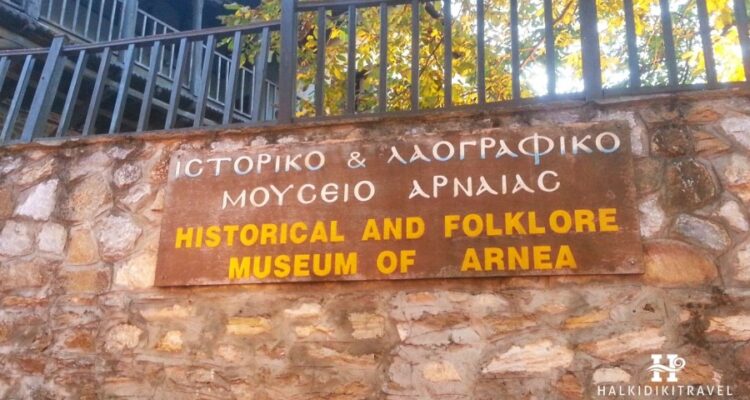The Historical and Folklore Museum of Arnaia is located in a narrow stone-built street near the central square of Arnaia and is part of the historic center of the settlement. It is housed in the mansion of the then doctor, and is the oldest in Halkidiki. It is dated around the second half of the 18th century to the beginning of the 19th. The building belonged to Konstantinos Katsangelos and housed the folklore collection, which was installed by the Cultural and Educational Association of Arnaia. It has been operating as a museum since the summer of 1999 and today belongs to the Municipality of Aristotelis.
The mansion is one of the best preserved and most impressive pieces of architecture in Arnaia, probably the work of craftsmen who came from Epirus. It is a peculiar building, built on a plot with a strong slope. Morphologically, it is a traditional house of Arnaia with a dense construction and various forms of the external and internal structural elements.
It is a simple and strict two-story building. Its layout is P-shaped. The ground floor consists of two rooms, a windowless one that apparently functioned as a stable, and a second room, to the right of the entrance that has an independent entrance, which communicated via an internal staircase with the second floor. Its northwestern part is designed to look like a tower, with small openings on the floor and small built arches at floor level.
The second floor included two rooms and the characteristic building element of the local architecture, the loggia (roofed porch), which runs along the main face and is supported by wooden lintels. The loggia formed the core of the residence. It was used as a place of gathering, a reception and summer accommodation. At the same time, it helped with the household activities. The wooden constructions of the hallway are particularly elaborate with relief details, which is proof that this house belonged to a well off family of Arnaia.
The mansion is an exquisite example of local traditional architecture. It was characterized by Melina Merkouri, when she was Minister of Culture, as a “work of art” and a “jewel” for the region. Its repair was approved by ministerial decision (Government Gazette 866/tb΄/2.11.82), thus making it imperative to make every effort to preserve these historic buildings of Arnaia.
The need to establish and operate a Historical and Folklore Museum in Arnaia, with the aim of both saving and spreading its cultural wealth, was met with the warm and immediate acceptance from the local community. This reaction manifested itself quickly with the donation of objects of the folklore tradition from already existing collections, but also by individuals.
The residents of the area, who are also the only donors of the exhibits, deposited in the museum valuable and rare objects, family heirlooms, objects of used in everyday life, such as livestock care, agricultural and beekeeping tools, and a multitude of other objects of the historical and folklore tradition of place.
The Historical and Folklore Museum of Arnaia is not complicated. On the contrary, it has a concise and spherical picture of the course of the historical and folklore material world of the settlement. The exhibits are placed in showcases on the walls of the mansion and are presented in twelve small and distinct thematic units with semantic coherence on the ground and the first floor, and that allows the visitor to have a comprehensive view, without having the feeling of a limited and suffocating exhibition space.
Source: http://www.dimosaristoteli.gr/gr
Copyright 2023 © Created By Diadyktio, All Rights Reserved.
To provide the best experiences, we and our partners use technologies like cookies to store and/or access device information. Consenting to these technologies will allow us and our partners to process personal data such as browsing behavior or unique IDs on this site and show (non-) personalized ads. Not consenting or withdrawing consent, may adversely affect certain features and functions.
Click below to consent to the above or make granular choices. Your choices will be applied to this site only. You can change your settings at any time, including withdrawing your consent, by using the toggles on the Cookie Policy, or by clicking on the manage consent button at the bottom of the screen.

Congratulation!